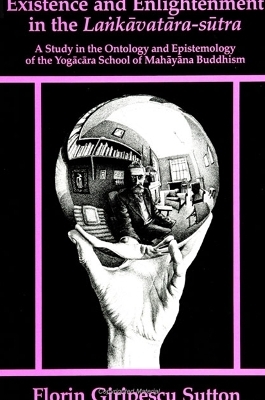
Existence and Enlightenment in the Laṅkāvatāra-Sūtra
State University of New York Press (Verlag)
978-0-7914-0173-6 (ISBN)
- Titel z.Zt. nicht lieferbar
- Versandkostenfrei innerhalb Deutschlands
- Auch auf Rechnung
- Verfügbarkeit in der Filiale vor Ort prüfen
- Artikel merken
The first part of the book outlines the three-fold nature of Being, as conceptualized in Buddhist metaphysics. The author uses an interpretive framework borrowed from the existentialist philosophy of Heidegger, in order to separate the transcendental Essence of Being from its Temporal manifestation as Self, and from its Spatial or Cosmic dimension. The second part clarifies the Buddhist approach to knowledge in its religious, transcendental sense and it shows that the Buddhists were actually first in making use of dialectical reasoning for the purpose of transcending the contradictory dualities imbedded in the common ways of perceiving, thinking, and arguing about reality.
Floring Giripescu Sutton is Assistant Professor of Oriental Philosophy at Rutgers University.
Introduction
0.1. The Purpose of the Study, and the Significance of the Lankavatara-sutra within Buddhist Doctrinal History
0.2. Dating the Text: Problems of Form and Interpretation
0.3. Methodology and Outline of the Study
Part One: Concepts of Being
1.0. The Nature of Buddhist Ontology
General considerations The practical aim of the Yogacara Philosophy
1.1. The Threefold Meaning of Tathagata-garbha and its Relation to Alaya-vijnana : the Essence of Being
Preliminary considerations Tathagata-garbha as essential, supramundane, pure dharma, and its contrast with the Hindu Atman Tathagata-garbha as embryo, and the dynamics of Buddhahood Tathagata-garbha as womb or matrix of Buddhahood Conclusion
1.2. The Five Skandhas: the Temporal Manifestation of Being
Introduction Brief overview of the Atman controversy prior to the Lankavatara-sutra Rupa, or the formative elements of the five Skandhas Nama, or the formless elements of the five Skandhas The Skandhas and the empirical self, or personality The Skandhas and the trans-empirical Self, the Tathagata The five Skandhas and the denial of metaphysical dualities Concluding remarks on the notion of Self and its varieties
1.3. Dharmadhatu : the Spatial or Cosmic Dimension of Being
Introductory remarks Dharmadhatu as cosmic Law: the fundamental structure of the universe Dharmadhatu as universal Void: the ground of Being Concluding observations
Part Two: Concepts of Knowing
2.0. Buddhist Epistemology, Buddhist Dialectics
Truth, untruth, half-truth, "the truth" The tetralemma logic: a thousand years of Buddhist dialectics The early use of the tetralemma in the Pali canon Rationality and irrationality in Nagarjuna's relativistic logic Epistemology in the Lankavatara-sutra : a radical critique of language, logic, and knowledge Conclusions and preview of part two
2.1. The Epistemological Reduction of the Citta-matra (Mind-only) Doctrine
Preliminary considerations Citta as the empirical mind Citta as the transcendental Mind Citta-matra as explanation for the triple world (Tribhava) Concluding words and the connection between Lankavatara and Zen
2.2. From Mind to No-mind: the Transcendental Leap beyond Empirical Cognition
Introduction The five Dharmas or epistemic categories The three Svabhavas or modes of cognition The attainment of Aryajnana : transcendental Wisdom or Gnosis Concluding remarks
2.3. The Conjunctive System of the Eight Vijnanas : the Integration of Both Mind and No-mind States of Consciousness
Introductory remarks Jnana and Vijnana : abstract intuition versus concrete knowledge Khyati- and Vastuprativikalpa-vijnana : the perceptual and the object-discriminating knowledge The inner revolution (Paravrtti ): the return to the tranquil state of pure consciousness (Alaya-vijnana ) Conclusion
2.4. The Disjunctive Theory of Causation: Things are Neither this, Nor that, for They Are All Subject to Causes and Conditions (Hetu-pratyaya)
Introduction The expansion of the relevance of causation: from the psychological to the cosmic-philosophical principle Causation as a possible theoretical basis for a monistic view of the world Causation as a teaching device Excursus: highlighting Nagarjuna's thought in respect to causation The soteriological value of the theory of causation Concluding observations
3.0. Final Overview
Appendix
Notes
Bibliography
Index
| Erscheint lt. Verlag | 27.11.1990 |
|---|---|
| Reihe/Serie | SUNY series in Buddhist Studies |
| Zusatzinfo | Total Illustrations: 0 |
| Verlagsort | Albany, NY |
| Sprache | englisch |
| Maße | 152 x 229 mm |
| Gewicht | 227 g |
| Themenwelt | Geisteswissenschaften ► Religion / Theologie ► Buddhismus |
| ISBN-10 | 0-7914-0173-1 / 0791401731 |
| ISBN-13 | 978-0-7914-0173-6 / 9780791401736 |
| Zustand | Neuware |
| Haben Sie eine Frage zum Produkt? |
aus dem Bereich


